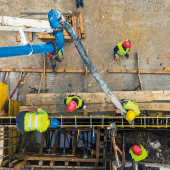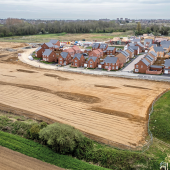Higher Risk Building (HRB) Registration Q&As

This special Q&A article explains why the Building Safety Act 2022 was introduced, the changes in relation to dutyholders, and how the changes will impact the role of the new accountable persons.
Why has the new Building Safety Act 2022 been introduced?
The Independent Review of Building Regulations and Fire Safety, led by Dame Judith Hackitt after the Grenfell Tower tragedy, revealed shortcomings in the construction, management, and maintenance of many higher rise building structures.
The subsequent report Building a Safer Future described the necessity for ‘a radical overhaul to futureproof the system’ and made recommendations for a more robust regulatory system and enhancements to the building safety framework.
The government took forward these recommendations, and after consultation with the industry, introduced the new Building Safety Act (2022).
What are the changes to the Building Safety Act (2022) in relation to the new dutyholder/accountable person roles?
The Building Safety Act (2022) recognises new duty-holder roles, ‘accountable persons’ (APs), for residential higher-risk buildings (HRBs). These AP’s have responsibility for managing the fire and structural safety of a higher-risk building.
The AP’s new statutory responsibilities include having a duty to take all reasonable steps to:
- prevent a building safety risk happening, with building safety risk, defined by the HSE as ‘spread of fire and/or structural failure’*; and
- reduce the seriousness of an incident if one happens.
The AP with responsibility for the overall structure and exterior of the building will be known as principal accountable person (PAP) and their additional duties will include:
- registering existing buildings with the Building Safety Regulator (BSR), before October 2023; and
- registering all new buildings before occupation.
The changes also introduced clear accountability for the AP, transferring the responsibility for proving competence to the individuals undertaking the roles. This significant change makes it the responsibility of the individual to prove that they have the suitable knowledge, skills and experiences to execute their role as an AP in a more granular way.
The Building Safety Act (2022) requires that competent people are hired by clients and contractors, and one of the key challenges will be how to prove that they are competent.
We have shortages in the sector, and in the short term, there will be a significant amount of upskilling and reskilling as we get used to the new statuary changes.
However, long term, the construction industry will be in a much healthier position. By only employing professionals with proven competence creates a benefit for the marketplace, and bodes well for the long-term future of the sector.
When do these changes come into effect for the AP?
The additional changes to the roles and responsibility came into effect in October 2023.
Which professions now have dutyholder responsibility?
Clients, designers, principal designers, contractors and principal contractors, and those with maintenance responsibilities will now have clear accountability and need to prove they understand their own obligations when working on HRBs.
What are their new responsibilities and how will the changes to the Building Safety Act impact the role of the new accountable persons?
Their new duties will be to plan, manage and monitor their activities in relation to building regulations.
Moving forwards, if you’re involved in the provision, design, operational maintenance and construction of a HRB, much clearer duties are imposed on you. Importantly for those working as clients and contractors, the Building Safety Act (2022) aids in appointing competent people.
Therefore, it becomes essential that we have a common standard in the industry by which individuals can demonstrate their competence by discharging those duties.
What elements will be critical for public safety in the future?
Supporting the new duty holding regime will be new regulatory processes, including gateway approvals, mandatory safety cases and the ‘Golden Thread’ of information will be established.
This is critical for public safety in the future.
For HRBs in the future, the processes in the ways we procure and maintain these buildings will be much stricter, and controlled by the new Building Safety Regulator.
The gateways are hard-stop points for the regulator to assure that all the relevant safety factors have been taken into account. These key points will be through the building’s life cycle and include planning (gateway one), the detailed design stage (gateway two), or before occupation within the building. These become important new steps for which people working within the sector will have to comply with.
Due to the scope of people involved within each of these stages, it is really important that all of the safety-critical information is documented and passed onto the next stakeholders. Future users of the building must have the information they need to operate, maintain and improve the buildings safely.
How is the news of CABE becoming the first PEI to offer Engineering Council HRB registration important to me working as a professional on HRBs?
After Dame Judith Hackitt’s report, a number of UK professional engineering institutions (PEI’s) came together under the auspices of the Engineering Council to develop standards and methods by which individuals can demonstrate their competence. This is so when employing people to discharge duties under the Building Safety Act (2022), there is a ready and recognisable way for engineers to prove their competence. It’s important that the Engineering
Council members collaborated, and through this process, created a scheme that can drive consistency and confidence.
CABE is extremely proud to be at the forefront of that, to be the first of hopefully many institutions to provide these recognised qualifications so individuals can prove their competence, therefore allowing all of the benefits envisioned in the Building Safety Act (2022) and Dame Judith Hackitt’s report can come to fruition.
At this current moment in time, CABE is the first and only PEI to award professional HRB registration.
Who can apply and what are the benefits of applying for the Engineering Council HRB registration?
Clients, principal contractors, principal designers, and those with maintenance responsibilities can apply for the HRB registration.
By applying, those working on HRB’s can ensure that their competence levels are robustly tested, and with successful completion, this proves that they can be trusted to discharge their duties in their critical roles.
Engineering Council HRB Registration scheme is referred to as the general engineering requirements scheme, and specific schemes for building services, structural and fire engineering are going to be released later in the year.
How will the Engineering Council HRB Registration scheme work, and how will I have to prove my competence?
We have developed a tailored and contextualised version of our competency frameworks, that are adapted to cover the knowledge, understanding and skills required to discharge HRB roles.
Individuals then will have to demonstrate their competence through a portfolio of evidence, and a peer reviewed professional interview with a panel of other Chartered Engineers, who will assess their level of competence.
If successful, the individual will be registered and placed onto the Engineering Council’s new database of HRB-registered engineers, which will be readily available for public viewing.









